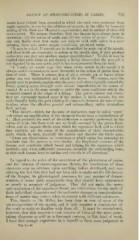Page 743 - My FlipBook
P. 743
AGENCY OF MICRO-ORGANISMS IN CARIES. 753 :
ments have indeed been recorded in which the teeth were protected from
septic agencies, in one by the addition of creasote, in the other by hermetic
sealing of the flask (see Magitot's experiments), and in neither of these did
caries occur. We assume, therefore, that two factors haye always been in
operation: (1) the action of acids, and (2) the action of germs. Further,
our own flasks show that malic and butyric acid, with saliya in a meat
infusion, haye not, under aseptic conditions, produced caries.
" It may be asked. If a tooth can be decalcified by acids out of the mouth,
and these acids are constantly in action in the mouth, then if they produce
caries why can they not produce simple decalcification ? To this it may be
replied that acids alone do not destroy a liying tissue—that the stomach is
not digested by |ts own acids until it has been remoyed from the body.
" 4. Lastly, we would ui"ge that when caries occurs in the mouth it is
always under circumstances more favorable to the action of germs than to
that of acids. There is always, first of all, a minute pit or haven where
germs can rest undisturbed and attack the tissue. We cannot, upon the
purely acid hypothesis, explain why the same acids that originally caused the
decay, gaining access through some minute imperfection of the armor of
enamel, do not in the same mouth or under the same conditions attack the
wounded enamel at the edges of a filling. The germs cannot rest there
they are constantly washed away if the surface is fairly smooth ; but the
acids literally bathe the part (during the intervals between the acts of mas-
tication, when the alkaline parotid and submaxillary saliva neutralizes
their action).
"This theory—which, for the sake of distinction, may be called 'septic'
—is rather an amplification of the chemical theory than a contradiction of
it. Most probably the work of decalcification is entirely performed by the
action of acids, but these acids are, we think, secreted by the germs them-
selves, and the organic fibrils upon which the organisms feed, and in which
they multiply, are the scene of the manufacture of their characteristic-
acids, which, in turn, decalcify the matrix and discolor the whole mass..
" From our observations on cementum to which caries has extended we-
conclude that the process is very similar : the bioplasmic contents of the
lacunDe and canaliculi afford board and lodging for the organisms, which
multiply, and, when sufficiently numerous, decalcify the surrounding bone,,
so that each lacuna loses its outline and extends in all directions."
In regard to the order of the occurrence of tlie phenomena of caries,
and the relation of micro-organisms thereto, the conclusions of these
observers were an advance upon anything before developed, and, con-
sidering; the fact that they had not been able to make out the life-historv
of the fungus, its physiological processes, by any manner of demon-
stration, it seems quite remarkable that they should have approached
so nearly to accuracy of judgment. They did not make the' neces-
sary separation of the organisms found, nor cultivations for the study of
their individual characters and the molecular changes or remoleculariza-
tions of matter they induce when in contact ^yith different substances.
This, thanks to Dr. ]Miller, has been done in case of some of the
micro-organisms of the mouth, and it only requires a continuance of
the work to make us familiar with them all. It must be remembered,
however, that this requires a vast amount of labor of the most pains-
taking character as well as a thorough training in this kind of work.
I have had enough experience in it myself to form some judgment in
Vol. I.—48


